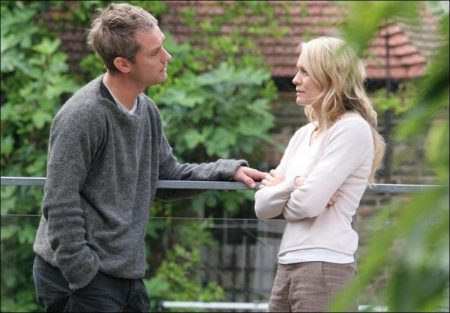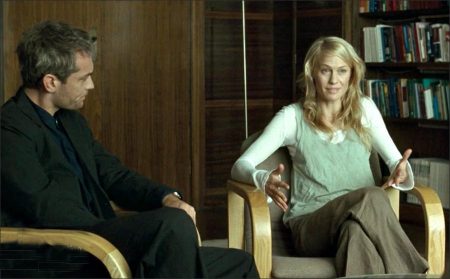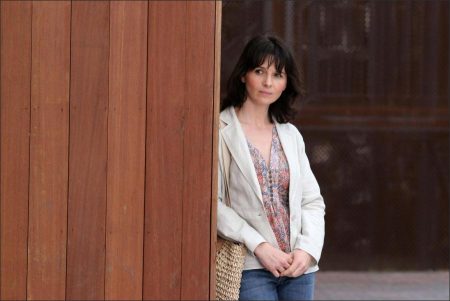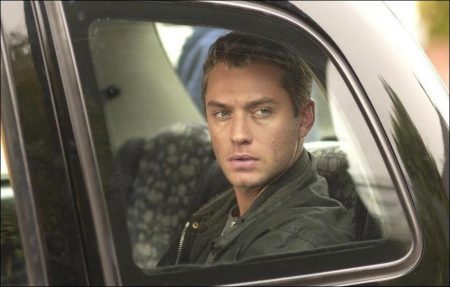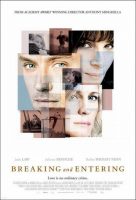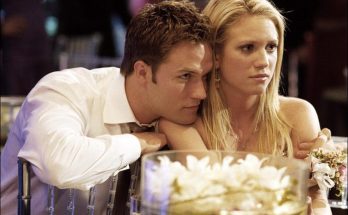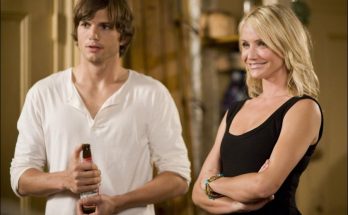Tagline: Love is no ordinary crime.
A story about theft, both criminal and emotional, “Breaking and Entering” follows a disparate group of long-term Londoners and new arrivals whose lives intersect in the inner-city area of King’s Cross. When a landscape architect’s (Jude Law) state of the art offices in a seedy part of town are repeatedly burgled, his investigations launch him out of the safety of his familiar world.
A story about theft, both criminal and emotional, “Breaking and Entering” follows a disparate group of long-term Londoners and new arrivals whose lives intersect in the inner-city area of King’s Cross. When a landscape architect’s (Jude Law) state of the art offices in a seedy part of town are repeatedly burgled, his investigations launch him out of the safety of his familiar world.
“Breaking and Entering” is Academy Award-winning director Anthony Minghella’s first original screenplay since his 1991 feature debut, “Truly Madly Deeply.” Minghella, Sydney Pollack and Timothy Bricknell are producing for Minghella and Pollack’s Mirage Enterprises.
Breaking and Entering tells the story of a series of criminal and emotional thefts, set against the backdrop of London’s changing culture and geography. Will (Jude Law) and his friend Sandy (Martin Freeman) run a flourishing landscape architecture firm that recently relocated to King’s Cross, the centre of Europe’s most ambitious urban regeneration site.
Their state-of-the-art studio office repeatedly attracts the attention of a local gang of thieves and Will, fed up after another break-in, chases one of the young gang members, Miro (Rafi Gavron), back to the apartment he shares with his mother Amira (Juliette Binoche), a Bosnian refugee.
At home, Will lives with his beautiful girlfriend Liv (Robin Wright Penn) who spends most of her time worrying about her troubled 13-year-old daughter Bea (Poppy Roger). Will befriends Amira to further investigate the burglary, but their friendship takes an unexpected turn. Amira soon discovers that Miro robbed Will’s office and becomes suspicious of his true intentions in their relationship. In a state of fear, she sets out to blackmail Will in order to protect her son. With his life already in crisis, Will embarks on a passionate journey into the wilder side of both himself and the city.
Introduction
Filmed on location in London and at Elstree Studios during the summer of 2005, Breaking and entering is Academy Award winning director Anthony Minghella’s first original screenplay to be produced since his 1991 feature debut, ‘Truly Madly Deeply.’ Produced by Minghella, Sydney Pollack and Timothy Bricknell for Mirage Enterprises (Minghella and Pollack’s production company) the film is a co-production between Miramax Films and The Weinstein Company.
Breaking and entering stars Jude Law who previously worked with Anthony Minghella on ‘Cold Mountain’ and ‘The Talented Mr Ripley’ and received Academy Award nominations for both performances; Juliette Binoche who won the Oscar for Best Supporting Actress for her role in Minghella’s ‘The English Patient,’ and American actress Robin Wright Penn who became a household name with her starring role in ‘Forrest Gump’ and was recently seen in ‘A Home at the End of the World.’ The cast includes Vera Farmiga, Ray Winstone, Martin Freeman, Rafi Gavron, Poppy Rogers and Juliet Stevenson.
The behind the scenes team includes production designer Alex McDowell (‘Fight Club,’ ‘Minority Report’) and cinematographer Benoit Delhomme (‘The Scent of Green Papaya, ‘Merchant of Venice,’ ‘Cyclo’). The original score is composed by Gabriel Yared (‘The English Patient,’ ‘The Talented Mr Ripley,’ ‘Cold Mountain’) and Rick Smith and Karl Hyde of the group Underworld.
Green Effect Manifesto
Buildings – architects design them, their thrusting shapes, their visual dramas, their interiors made to human scale, doors with handles we can open, windows we can see through, stairs we can climb…
Between buildings are spaces, female shapes, profound and important, but often neglected. There’s much more of this space than we appreciate, or recognise, even in cities; in the suburbs, in the sprawl around cities, this space dominates, and yet is rarely coherent, rarely planned, rarely understood, is often thought of as negative space, to contrast it with the bulky certainty of function possessed by a building. A building houses us at play, at work, in social gatherings.
But outside, in the built environment – for that is what these external spaces are – the built environment glues our living together, and people continue to want to play, work and gather in the open air. A glance at any park on any weekend, the magnet of unroofed spaces, should provide unassailable evidence for the importance of urban landscape. Nevertheless, the built environment continues to comprise miserable passages between buildings, beside roads, throttled and defined by false economies and failures of nerve.
Green Effect is certainly not against nature, although we are accused of being against nature. Rather, we are against the fraudulent advocacy of nature, the misnaming of mediated space as natural, the mistaking of grass as nature, of green as nature. We are against decoration – the flowerbed, the plant, the lawn – those miniature gestures of appeasement which nature would not recognise. Nature is not tame, by definition and there is no space in Britain or Europe that can be described without irony as natural. That a site is designated green space is already a gesture of control. It can be termed a national park or a wildlife sanctuary, its boundaries marked, its animal life monitored – Nature this way!
What Green Effect advocates is hardly modern. Nash was designing both internal and external spaces in the nineteenth century. The Regent’s Canal, Regent Street and Regents Park are all illustrations of a coherent arrangement of private and public environments – elegant terraces grouped around the park, with its inner and outer circles. Regent’s Park is made, of course, a construct no more or less natural than the curving rows of stucco buildings. The confident harmonies, which develop from this marriage of house and environment, have direct and positive impact on those who inhabit them.
It’s great to walk in the park and look at the facades; it’s great to look at the park from inside the buildings. These values are self-evident. The same is true of the Italian Piazza; its grandest expressions – in San Marco in Venice, the Piazza Navona in Rome – without a blade of grass, are as architectural, as pleasing, as defining as any building, as communal as any park. They say something about a culture in the way as our endless verges, our muddy borders, our clumps of bamboos, forlorn trees and concrete flower beds speak volumes about our current society and its lack of respect for what happens to our citizens when they leave their front doors travelling to the glass boxes of their offices. A glance at the budgets for enclosed spaces and exterior spaces indicate society’s true valuation of our constructed environments.
Green Effect views the built landscape as an art, and one which requires as much care as any structure, and as much acknowledgement of design. We believe that there has to be more than a token recognition by architects that they contribute to an environment gestalt; that the choreography of bound and unbound space should be determined as a whole and not simply with the one determining the other, I’m here, fill in around me. Every large scale Urban Project should employ landscape and building architects simultaneously, and Green Effect will only commit to projects where such a dynamic exists and where the possibility lies for the demands of landscape to genuinely effect the position and external characteristics of any structures. Where possible Green Effect will design both. It will favour environment, it will insist that harmonies between the so-called male and female spaces have political impact, not least on crime but most of all, that respect and wit towards exterior space improves the quality of life of every citizen. — Green Effect Partnership 2005
Continue Reading and View the Theatrical Trailer
Breaking and Entering (2006)
Directed by: Anthony Minghella
Starring: Jude Law, Juliette Binoche, Robin Wright-Penn, Martin Freeman, Vera Farmiga, Rafi Gavron, Ed Westwick, Romi Aboulafia, Eleanor Matsuura, Lisa Kay, Anna Chancellor
Screenplay by: Anthony Minghella
Production Design by: Alex McDowell
Cinematography by: Benoît Delhomme
Film Editing by: Lisa Gunning
Costume Design by: Natalie Ward
Set Decoration by: Anna Pinnock
Art Direction by : Andy Nicholson
Music by: Karl Hyde, Rick Smith, Gabriel Yared
MPAA Rating: R for sexuality and language.
Distributed by: MGM, The Weinstein Company
Release Date: December 8, 2006
Visits: 73
